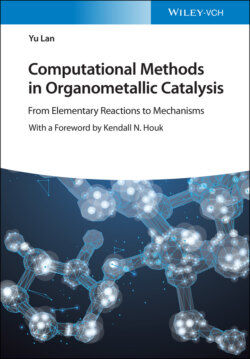Читать книгу Computational Methods in Organometallic Catalysis - Yu Lan - Страница 22
2.2 Density Functional Theory (DFT) Methods 2.2.1 Overview of Density Functional Theory Methods
ОглавлениеThe inefficiency of HF and post‐HF methods is the high computational effort that is required for the treatment of relatively large molecular systems. Therefore, it is rather complicated to solve. Fortunately, the total electron density of a molecule is only dependent on three variables in space, which is simpler than the electronic wavefunction and is also observable. It would offer a more direct way to obtain the molecular properties by the calculation of electron density.
The Hohenberg–Kohn existence theorem proves just that the ground state of any interacting many particle system with a given fixed inter-particle interaction is a unique functional of the electron density [36]. There exists a unique functional such that
where Eelec is the exact electronic energy. It could be considered to be a functional, in which the function ρ(r) depends on the spatial coordinates, and the energy depends on the values (is a functional) of ρ(r).
To solve for the energy via the density functional theory (DFT) method, Kohn and Sham proposed that the functional has the form
where Te′ is the kinetic energy of noninteracting electrons whose density is the same as the density of the real electrons, the true interacting electrons. Vne is the nuclear–electron attraction term. Vee is the classical electron–electron repulsion [37]. The last term is called the exchange–correlation functional, and is a catch‐all term to account for all other aspects of the true system. However, it offers no guidance as to the form of that functional.
The exchange–correlation functional is generally written as a sum of two components, an exchange part and a correlation part. This is an assumption, an assumption that we have no way of knowing is true or not. These component functionals are usually written in terms of an energy density ε
The major problem with DFT is that the exact functionals for exchange and correlation are not known except for the free electron gas. However, approximations exist, which permit the calculation of certain physical quantities quite accurately. One of the initial simple approximations of exchange–correlation functional is the local‐density approximation (LDA), in which the exchange–correlation functional of uniform electron gas with same density is used as the approximation of the corresponding nonuniform system [38]. Unexpectedly, such a simple approximation often yields good results, which directly led to the widespread application of DFT currently. If the electron densities of different spin components are further considered, the local spin density approximation (LSDA) can be obtained. Despite the great success of L(S)DA, there are many shortcomings, such as systematic overestimation of binding energies.
To make improvements over the L(S)DA, one has to assume that the density is not uniform. The approach that has been taken is to develop functionals that are dependent on not just the electron density but also derivatives of the density. This constitutes the generalized gradient approximation (GGA). It is at this point that the form of the functionals begins to cause the eyes to glaze over and the acronyms to appear to be random samplings from an alphabet soup. The method of constructing GGA exchange–correlation functional can be divided into two ways. One is the group headed by Becke, which believes that “everything is allowed.” Any formation of exchange–correlation functionals for any reason can be chosen, while the quality of this formation only depends on the comparison with real system. Another group, led by Perdew, believes that the development of exchange–correlation functionals should be based on certain physical laws, such as scaling relations and progressive behavior.
